In addition to forearm supination, the primary biceps brachii function is elbow flexion, which is to say moving your forearms toward your biceps. Kettlebell bicep exercises are particularly effective in this regard because they train both of these main functions simultaneously.
Related: Kettlebell tricep exercises
Top 7 kettlebell bicep exercises
There are many kettlebell exercises for biceps that you can perform to build muscle. We tried over 10 different movements and came up with our list of the top 7 bicep kettlebell exercises for hypertrophy.
1. Standing kettlebell curl

Kettlebell bicep curls are a simple yet effective muscle-building exercise that you can perform virtually anywhere. All you need is a kettlebell—or two—and a small amount of workout space.
This movement is especially effective for building mass because it enables you to lift heavier weights than the other exercises due to its focus on the biceps as a whole.
Perform it standing to engage more of your core muscles, or try the seated version (the form is the same for both) to better isolate your biceps.
- Hold two kettlebells by your sides with a supinated grip.
- Curl the kettlebells toward your front delts.
- Squeeze your arms as the undersides of your forearms make contact with your biceps.
- Hold the contraction for a moment and then lower the weights under control until your elbows reach full extension.
- Perform 3-5 sets of 8-15 reps in total.
2. Kettlebell hammer curl
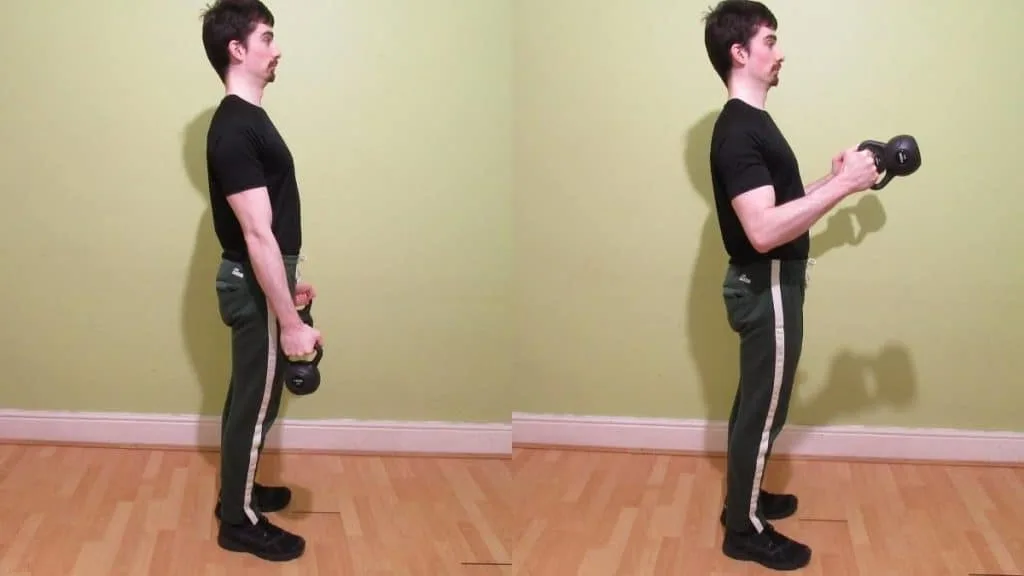
The hammer kettlebell bicep curl is a great training drill to do if you want to build your biceps and forearms simultaneously. This is because your forearms have to perform isometric radial deviation in order to keep your wrists straight during this exercise.
The downside is that you’ll have to lighten the weight because there’s no way that your radial deviation strength will be able to keep up with that of your biceps.
Still, considering that most lifters neglect this lower arm function (the forearms move from side to side as well as up and down), you’ll build a more complete upper body by incorporating this move into your kettlebell bicep workout.
- Hold two kettlebells by your sides with a neutral grip.
- Raise the kettlebells toward your shoulders while keeping your wrists as straight as possible.
- Flex your biceps and brachioradialis as your forearms press up against your biceps.
- Hold the contraction for a second and then lower the weights under control until your elbows are locked out.
- Perform 3-5 sets of 8-15 reps in total
3. Kettlebell incline curl
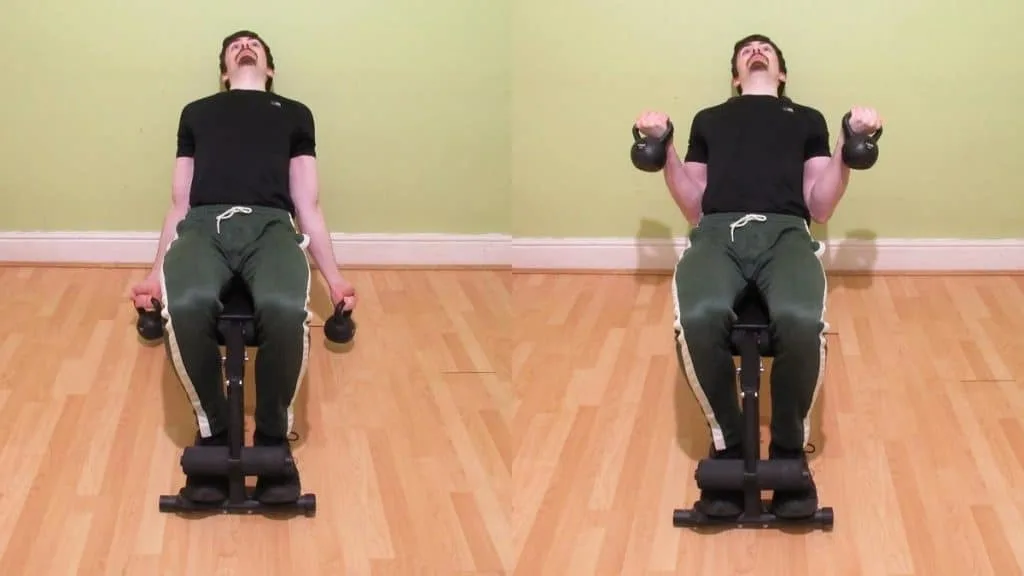
The incline kettlebell curl emphasizes the long head of your biceps because curling with your arms behind your body shifts the emphasis onto the outer muscle fibers of the biceps.
This can help you to develop a better bicep peak.
But the movement is also generally one of the best kettlebell bicep exercises because it provides much more consistent resistance than something like a spider kettlebell curl, which only becomes challenging when your biceps are maximally contracted.
- Set the backrest of an incline bench to between 45 and 60 degrees.
- Grab a pair of kettlebells with an underhand grip.
- Sit on the bench and lie on the backrest so that your shoulder blades are pinned back.
- Let your arms hang over either side of the bench, slightly behind your torso.
- Curl the weights toward your shoulders while keeping your elbows still.
- Keeping lifting until your forearms and biceps make forceful contact.
- Hold the contraction for a moment and then slowly lower the weights until your elbows are fully locked out.
- Repeat for 3-5 sets of 6-12 reps.
4. Kettlebell preacher curl
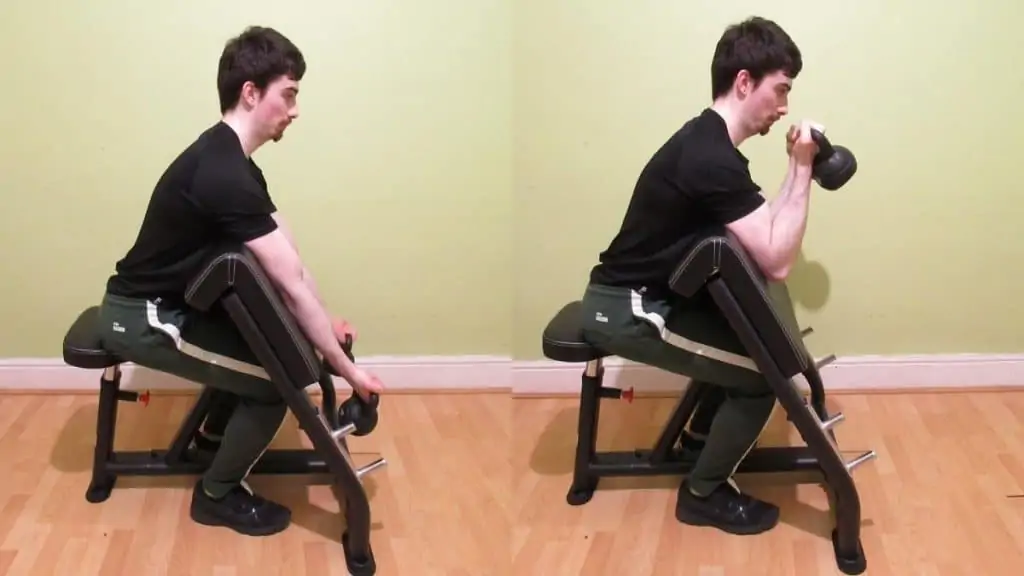
Preacher kettlebell curls are an ideal KB bicep exercise if you often struggle to maintain the proper lifting form during similar movements (i.e., if you have a tendency to cheat the weight up with momentum).
This is because you can’t effectively swing the weights up with your legs, hips, back, or shoulders when all of these body parts are stabilized by the preacher curl station. As such, your biceps naturally have to handle most of the heavy lifting, which also means that they get to enjoy more of the tension.
Ultimately, your biceps will grow larger because they have to do more work.
- Grab a kettlebell with a supinated grip and sit on a preacher curl station.
- Brace your arm (the one that’s holding the kettlebell) against the sloped side of the pad.
- Hold onto the top of the pad with your other arm for support.
- Curl the weights toward you by flexing your bicep.
- Squeeze your bicep as it touches your forearm, and then release the contraction by lowering the weight under control until your elbow is almost fully locked out.
- Repeat the motion with your other arm and do 3-5 sets of 8-12 reps per side.
5. Kettlebell concentration curl
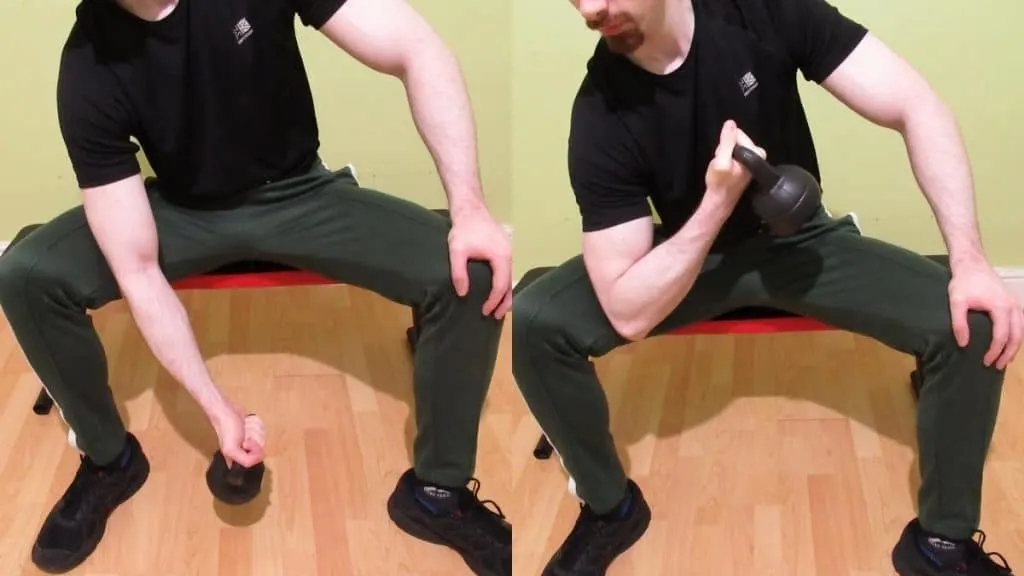
Concentration kettlebell curls are convenient and highly effective. All you need is one kettlebell and a comfortable place to sit. For this reason, it’s definitely worth including in your kettlebell bicep workouts if you train at home.
You can do this drill in a standing position, where you essentially bend over to a 90-degree angle, let your arm hang, and then curl the kettlebell. This version is ideal if you don’t have a weight bench or a comfortable sitting position (like a chair or sofa).
This tutorial, however, covers the seated version because most people will be able to evoke a better mind-muscle connection when they’re sat down because their core will be more stabilized.
- Grab a kettlebell, and then sit down with your knees apart.
- Brace the arm that’s holding the weight against the inside of your leg.
- Let the kettlebell stretch your bicep out so that your elbow is completely extended. This is the starting position.
- Curl the weight toward your front delt and contract your bicep as it touches your forearm.
- Squeeze your biceps as hard as you can for a full second, and then lower the weight under control until your elbows are once again fully extended.
- Perform 3-5 sets of 8-15 reps, and don’t forget your other arm!
6. Kettlebell reverse curl
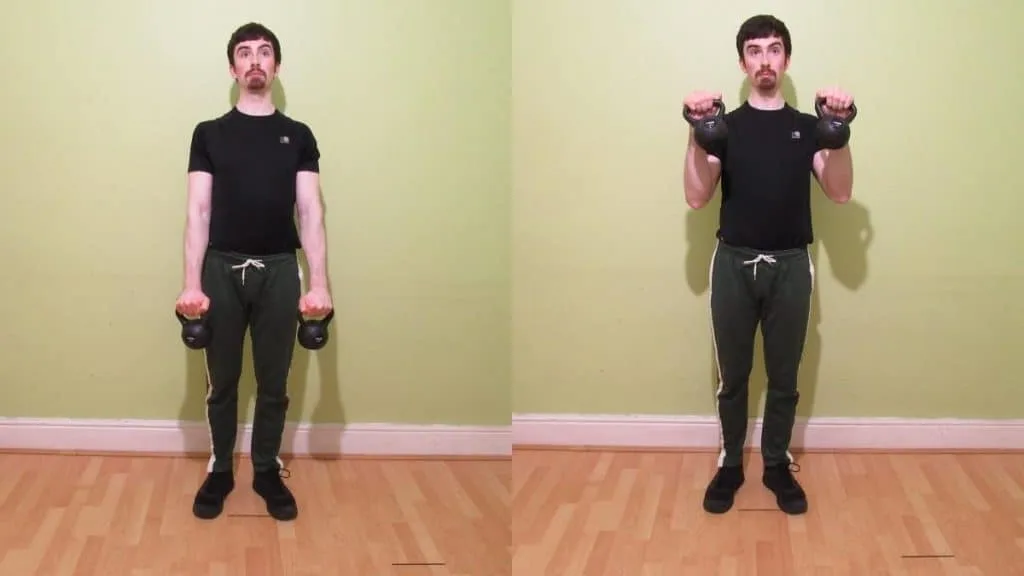
If you want to enhance your overall arm aesthetics by developing your brachialis and brachioradialis muscles in addition to your biceps, then the kettlebell reverse curl is one of the best exercises for the job.
Since this movement places your biceps in a position of mechanical disadvantage where they can’t supply much force, you’ll have to lift lighter than on other kettlebell biceps exercises. However, the benefit of more proportional arms (most lifters have lagging brachialis and brachioradialis muscles) is definitely worth the trade-off of lifting less resistance if you’re a bodybuilding enthusiast.
You can also give kettlebell Zottman curls if you want to do an exercise that builds your biceps and forearms simultaneously.
- Hold a pair of kettlebells by your sides with an overhand grip.
- Curl the weights toward the front of your shoulders.
- Keep lifting until the tops of your forearms press up against your biceps.
- Pause at the top of the rep for a second, and then lower the weights under control until your elbows reach full extension.
- Perform 3-5 sets of 8-15 reps in total.
7. Kettlebell crush curl
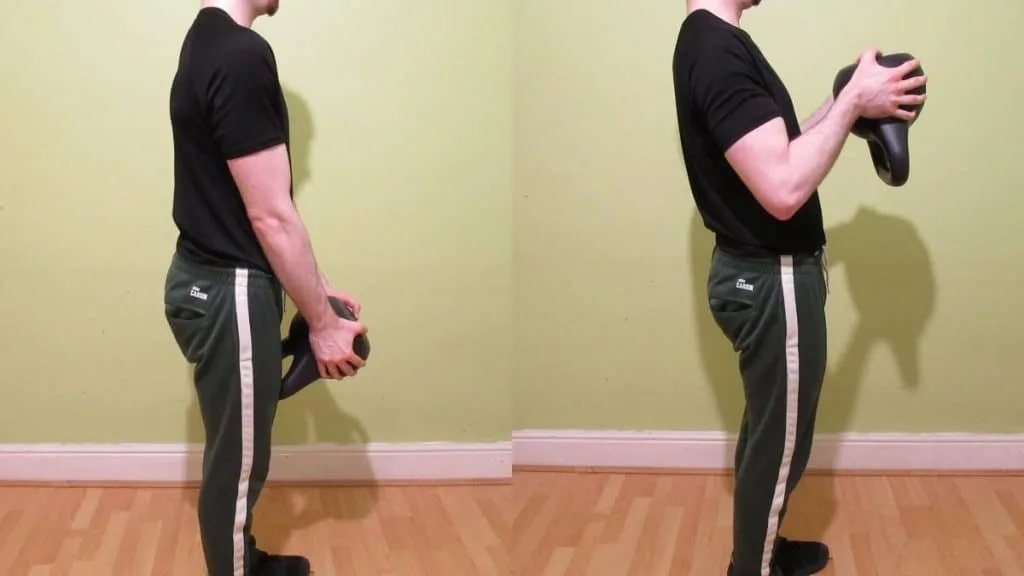
The kettlebell crush curl essentially mimics a hammer curl. The difference is that the crush curl relies on your grip strength to a greater degree, especially if you’re gripping large-diameter kettlebells.
- Hold the weighted part of a kettlebell at the sides with both hands. The handle should be facing down.
- Curl the bell toward your chest by moving your forearms toward your biceps.
- Flex your arms forcefully as your forearms and biceps make contact.
- Hold the contraction for a brief second, and then lower the kettlebell back down to your thighs.
- Repeat for 3-5 sets of 8-15 reps.
Full kettlebell bicep workout routines
Using the good old kettlebell for biceps is a great idea because kettlebells are incredibly versatile. Essentially, any exercise that you can do with dumbbells, you can do with kettlebells as well (see our dumbbell vs kettlebell curls comparison for more info).
Below you’ll find two bicep kettlebell workouts that each help you to achieve similar yet slightly different goals. The first workout prioritizes muscle growth (hypertrophy), while the other workout emphasizes strength gain, with hypertrophy as a secondary focus.
Workout 1: Muscle growth
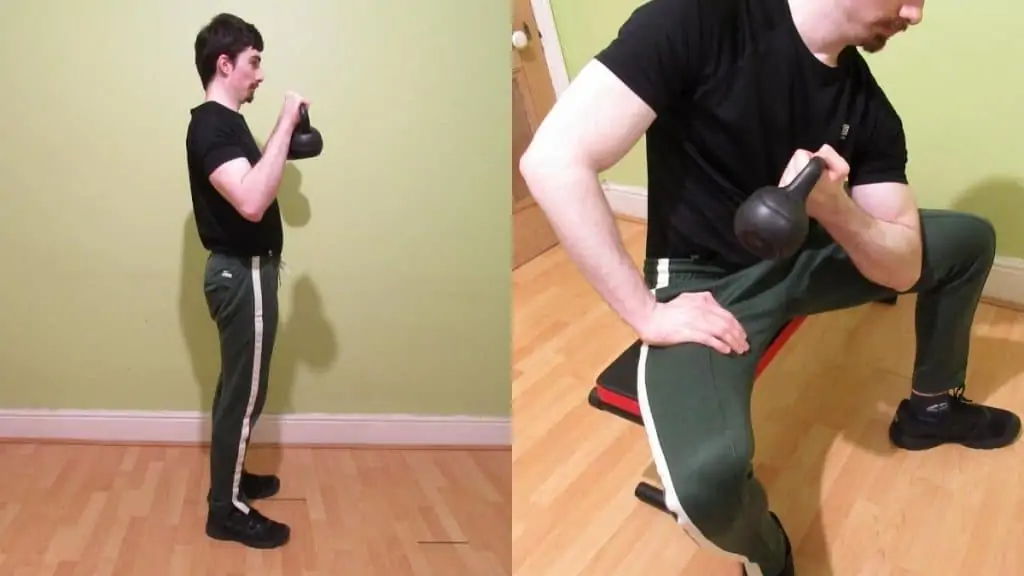
If you just want to beef up your biceps as effectively as possible, then this is the kettlebell bicep workout for you. We start heavy with a proven mass-building exercise to add size to the biceps. Then, after 3-5 sets, we switch gears and focus on the brachioradialis and brachialis, which are two muscles that most lifters neglect and which can really improve the appearance of your arms.
Then we move onto a unilateral exercise to really focus on each bicep to make sure that it gets the attention it deserves. Finally, we challenge our biceps and forearms simultaneously by performing high rep hammer curls.
1: Standing Curl — 3-5 sets of 6-10 reps
2: Reverse Curl — 3-5 sets of 10-15 reps
3: Concentration Curl — 3-4 sets of 8-12 reps
4: Hammer Curl — 3 sets of 12-15 reps
Workout 2: Strength development
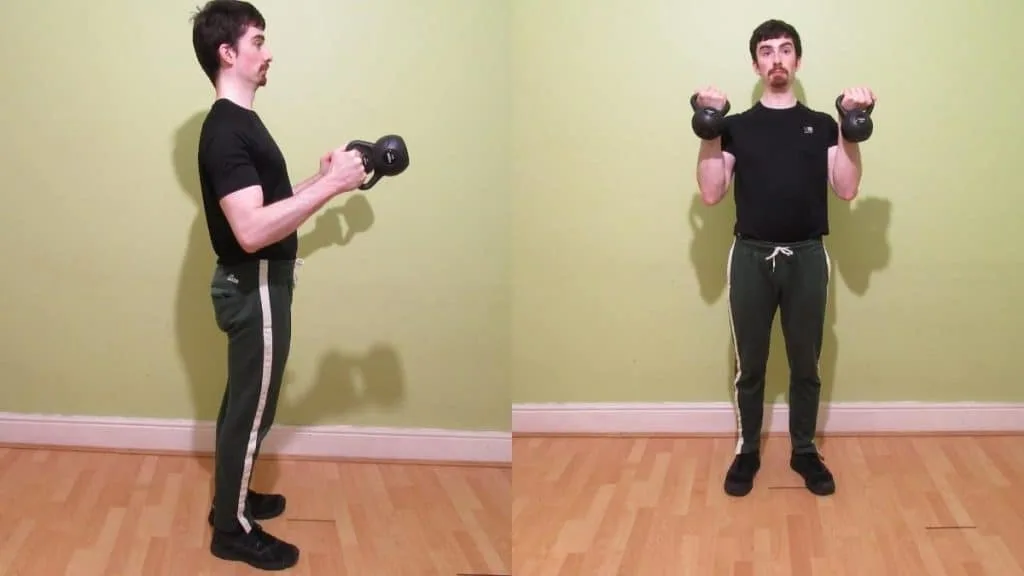
Follow this biceps kettlebell workout if you want to develop freakishly strong biceps. We begin with standard curls to focus on overall mass and strength. Then we tax our biceps and forearms together by tackling the tough kettlebell variation of the Zottman curl for a minimum of 4 sets.
As the workout progresses, we hit it hard with hammer curls to focus on that all-important radial deviation strength. And then, finally, we unleash our inner bodybuilder and pump up our arms with a few sets of high reps crush curls to focus on the slow-twitch muscle fibers.
1: Standing Curl — 5 sets of 6-8 reps
2: Zottman Curl — 4-5 sets of 8-10 reps
3: Hammer Curl — 3-4 sets of 8-10 reps
4: Crush Curl — 2-3 sets of 15-20 reps
Conclusion: Are kettlebells good for building the biceps?
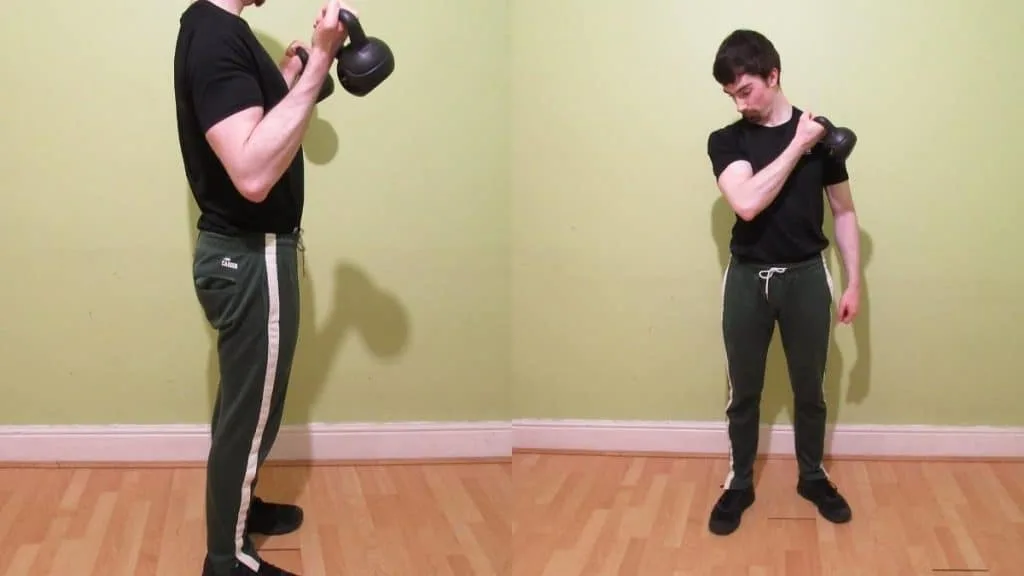
Kettlebell bicep exercises are excellent for building muscle mass and developing strength. They’re especially useful if you enjoy functional training and want to work out with kettlebells as frequently as possible so that you can get used to gripping them.
The only slight downside is that, depending on your gym, you might not always have access to kettlebells that ascend in manageable increments. This can make it hard to gain strength because the weight jumps may simply be too large for a small muscle group like the biceps.
You can follow one of our routines, or, for more customization, you can create your own kettlebell bicep workout from the list of exercises that we provided.
References
- Tavel, R. (2018, November 21). How You Can Use Hypertrophy to Grow Your Muscles. Men’s Health. https://www.menshealth.com/fitness/a25252586/muscle-hypertrophy/
- Vancini, R. L., Andrade, M. S., Rufo-Tavares, W., Zimerer, C., Nikolaidis, P. T., & de Lira, C. A. B. (2019). Kettlebell Exercise as an Alternative to Improve Aerobic Power and Muscle Strength. Journal of Human Kinetics, 66(1), 5–6. https://doi.org/10.2478/hukin-2018-0062

